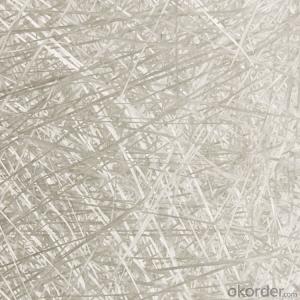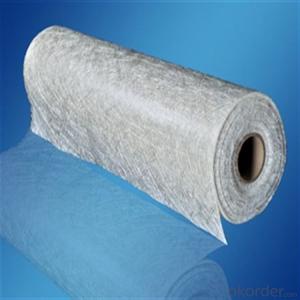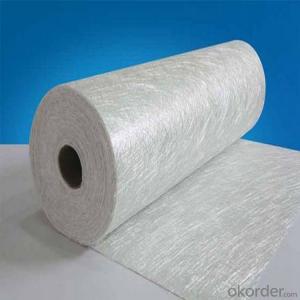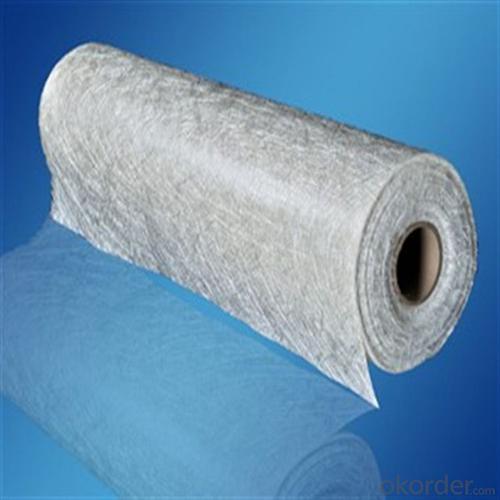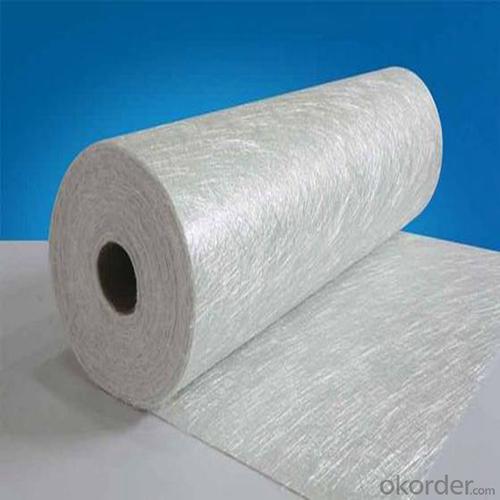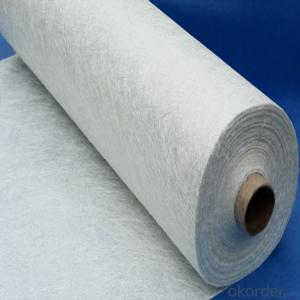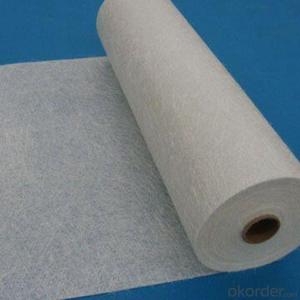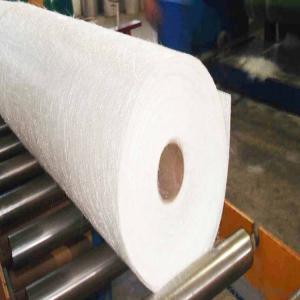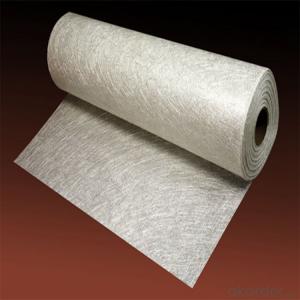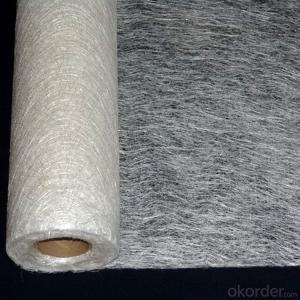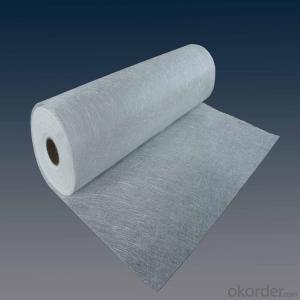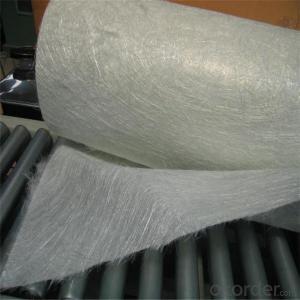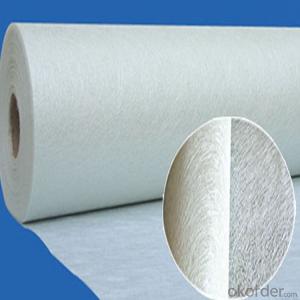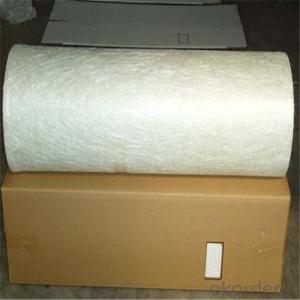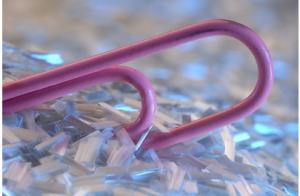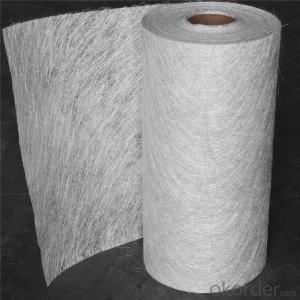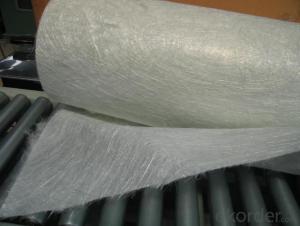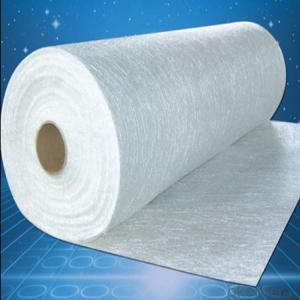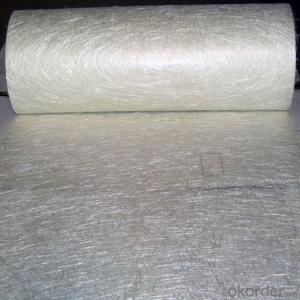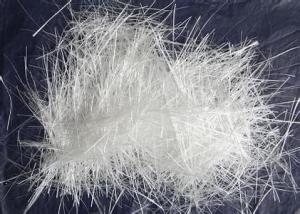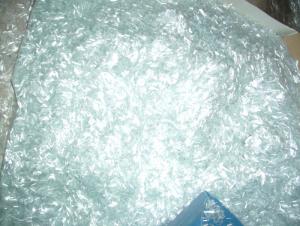Chopped Strand Fiberglass Mat (CSM) Technique and E-Glass Fiberglass Type chopped strand mat
- Loading Port:
- China main port
- Payment Terms:
- TT OR LC
- Min Order Qty:
- 1 kg
- Supply Capability:
- 10000 kg/month
OKorder Service Pledge
OKorder Financial Service
You Might Also Like

Product Description:
Fiberglass Chopped Strand Mat is fine strand reinforcement material made from E-glass cut fibers laid in a random pattern and bonded with powder or emulsion binder.
It is easy to handle and has excellent moulding performance.
Also, it has rapid resin penetration together with a fast strand wet out time.
The mat also brings a highly translucent finished laminates.
Also,the fine strand input makes the fiber prominence at the finished laminates surface extremely low.
Features
1.Excellent weight uniformity
2.Fast wet out
3.Easy air release
4.Excellent transparency of finished products
5.Excellent laminate
6.Low resin consumption
Application
1.Translucent roof panel
2.chemical storage tanks
3.FRP pipes
4.Boat hulls
5.Decks
6.Truck body panel
7.Cooling towers
8.Corrosion resistand
Specifications:
Item | Over Density | Moisture Content | Chop Density | Polyester Yarn | Width |
(g/m2) | (%) | (g/m2) | (g/m2) | (mm) | |
EMK300 | 309.5 | ≤0.15 | 300 | 9.5 | 50-3300 |
EMK380 | 399 | 380 | 19 | ||
EMK450 | 459.5 | 450 | 9.5 | ||
EMK450 | 469 | 450 | 19 | ||
EMC0020 | 620.9 | 601.9 | 19 | ||
EMC0030 | 909.5 | 900 | 9.5 |
Special products are available according to customer’s requirement.
Product Packaging:
Each Surface Tissue is wound onto a paper tube which has an inside diameter of 76mm and the mat roll has a diameter of 330mm. The mat roll is wrapped up with plastic film,and then packed in a cardboard box or wrapped up with kraft paper. The rolls can be vertically or horizontally placed. For transportation, the rolls can be loaded into a cantainer directly or on pallets.
Quantity
20'GP Container:About 10000kgs
40'HP Container:Aboout 23100kgs
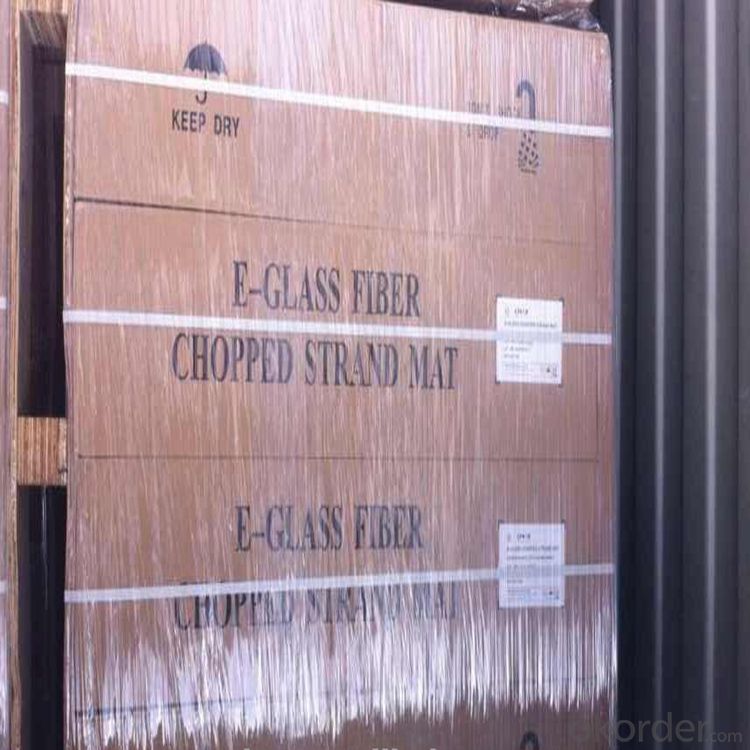
Product Storage:
Unless otherwise specified, Chopped Strand Mat should be stored in a dry, cool and rain-proof area. It is recommended that the room temperature and humidity should be always maintained at 15℃~35℃ and 50%~75% respectively.
Company Information
CNBM (China National Building Material) Group is the largest comprehensive building materials group in China that in integrate scientific research, manufacturing and logistics into one entity. The largest building materials and equipment specialists in China. Upon State Council approval, today CNBM owned more than 300 subordinate manufacturing factories and servicing companies. There are 6 fully owned public listed companies and 11 partially owned with substantial shares public listed companies. In many of these fields, CNBM is playing the leading role in the building industry in the country.

Our Service:
1.Any inquiry will be replied within 24 hours.
2.Professional manufacturer.
1) Print logo in the products;
2) The size and specification can be produce and design according to your demand.
3.High quality,fashion designs,reasonable and competitive price,fast lead time.
4.After-sale service
1) All products will have been strictly quality check in house before packing.
2) All products will be well packed before shipping.
3) All our products have 10 years rot resistance.
5.Faster delivery:sample order in stock,and 15-20 days for bulk production.
6.Payment:you can pay for the order via:T/T,Western Union,MoneyGram,L/C etc.
FAQ:
which kind of glass fiber sample and materials can you provide?
We can provide the glass fiber and glass fiber down stream products samples of E glass, C glass, ECR glass, High alkali glass. The products includes single end roving, assembled roving for different applications( Piping, SMC, panel, winding mill plate) , chop strand for BMC, engineering plastic (PA, PPA, PPT, POM, etc), chop strand mat (from 100gsm-900gsm) for automobile and water tank, etc, woven roving (270gsm-800gsm), surface tissue (25-50gsm), multi-axial fabric of different unit weight.
- Q: What are the mechanical insulation properties of fiberglass chopped strand?
- Fiberglass chopped strand is a type of mechanical insulation material that possesses several beneficial properties. Firstly, it has excellent thermal insulation properties, allowing it to effectively prevent heat transfer and maintain temperature stability in various applications. This makes it suitable for use in insulation systems for pipes, tanks, and other equipment that require temperature control. Additionally, fiberglass chopped strand is known for its high tensile strength and durability. It has a strong resistance to impact and can withstand mechanical stresses, making it a reliable insulation material for applications that require protection against structural damage or vibrations. This property also allows it to maintain its insulating capabilities over a long period of time without degradation. Furthermore, fiberglass chopped strand is resistant to moisture and does not easily absorb water. This makes it an ideal choice for insulation in humid or wet environments, as it will not lose its insulation properties when exposed to moisture. Another important mechanical insulation property of fiberglass chopped strand is its ability to resist the growth of mold and mildew. This is due to its non-porous nature, preventing the accumulation of moisture and creating an inhospitable environment for microbial growth. This feature is particularly advantageous in insulation applications where hygiene and cleanliness are crucial, such as in hospitals or food processing facilities. Overall, fiberglass chopped strand offers excellent mechanical insulation properties, including thermal resistance, durability, moisture resistance, and resistance to mold and mildew growth. These properties make it a versatile and reliable choice for a wide range of mechanical insulation applications.
- Q: Can fiberglass chopped strand be used in energy storage applications?
- Yes, fiberglass chopped strand can be used in energy storage applications. Fiberglass is a versatile material known for its high strength-to-weight ratio and resistance to corrosion, making it suitable for various industrial applications. In energy storage, fiberglass chopped strand can be utilized to reinforce and strengthen components such as battery casings, enclosures, and structural supports. It provides excellent mechanical properties, including tensile strength and dimensional stability, which are important for ensuring the integrity and durability of energy storage systems. Additionally, fiberglass is non-conductive and non-magnetic, making it a safe and reliable choice for electric and magnetic fields associated with energy storage applications.
- Q: Can fiberglass chopped strand be used in electrical insulating applications?
- Yes, fiberglass chopped strand can be used in electrical insulating applications. Fiberglass is an excellent insulator and has high dielectric strength, making it suitable for use in electrical insulation. Chopped strand fiberglass can be used to reinforce and insulate various electrical components such as transformers, circuit boards, and electrical cables. It provides mechanical strength, thermal insulation, and electrical insulation properties, making it a versatile material for electrical applications. Additionally, fiberglass chopped strand is resistant to moisture, chemicals, and fire, further enhancing its suitability for electrical insulating purposes.
- Q: Can fiberglass chopped strand be used in the production of consumer packaging?
- Yes, fiberglass chopped strand can be used in the production of consumer packaging. Fiberglass chopped strand is a reinforcement material that is made from strands of fiberglass chopped into small pieces. It is commonly used as a reinforcement material in various applications, including consumer packaging. When used in consumer packaging, fiberglass chopped strand can provide added strength and durability to the packaging material. It can help to prevent the packaging from tearing or breaking, ensuring that the product inside remains secure and protected. Additionally, fiberglass chopped strand can enhance the overall structural integrity of the packaging, making it more resistant to external pressures and impacts. Furthermore, fiberglass chopped strand is lightweight and versatile, making it suitable for various types of consumer packaging materials. It can be easily incorporated into plastics, paper, or other packaging materials during the manufacturing process. This allows for flexibility in design and customization of the packaging, while still providing the necessary strength and durability. Overall, the use of fiberglass chopped strand in the production of consumer packaging can help to improve the quality and performance of the packaging material, ensuring that it meets the requirements and expectations of consumers.
- Q: What is the typical fiber length of fiberglass chopped strand?
- The typical fiber length of fiberglass chopped strand is around 1 to 3 inches.
- Q: How to mill glass into powder?
- Milled glass fiber is made from specially drawn continuous glass fiber by chopping, grinding and sieving.
- Q: Can fiberglass chopped strand be used for reinforcing polymer matrix composites?
- Yes, fiberglass chopped strand can be used for reinforcing polymer matrix composites. Fiberglass chopped strand consists of short lengths of fiberglass strands that are randomly oriented. These chopped strands are mixed with a polymer matrix, such as epoxy, polyester, or vinyl ester resin, to create a composite material. The fiberglass chopped strand provides reinforcement to the polymer matrix by improving strength, stiffness, and impact resistance. The orientation of the chopped strands helps distribute the load evenly throughout the composite, making it stronger and more durable. Furthermore, the use of fiberglass chopped strand in polymer matrix composites offers several advantages. It is lightweight, corrosion-resistant, and has excellent electrical insulation properties. It also provides good dimensional stability and can be easily molded into complex shapes. Overall, fiberglass chopped strand is an effective and commonly used reinforcement material for polymer matrix composites, making it suitable for various applications such as automotive parts, aerospace components, construction materials, and consumer products.
- Q: Is fiberglass chopped strand recyclable?
- Yes, fiberglass chopped strand is recyclable. Fiberglass is made from glass fibers that can be melted down and reused to create new products. The recycling process involves crushing the fiberglass into small pieces, melting it down, and then reforming it into new fiberglass products. Recycling fiberglass chopped strand not only helps to reduce waste and conserve resources, but it also has environmental benefits by reducing the need for virgin materials.
- Q: How does the diameter of the chopped strand affect its performance?
- The performance of the chopped strand is significantly influenced by its diameter. When the diameter is smaller, the performance characteristics, such as tensile strength and adhesion properties, are typically improved. To begin with, a smaller diameter chopped strand provides a higher ratio of surface area to volume. This increased surface area allows for better bonding with the resin matrix in composite materials, leading to improved mechanical properties. Moreover, the smaller diameter facilitates better resin penetration, ensuring a more even distribution of the resin throughout the composite structure. Consequently, the overall strength and structural integrity of the final product are enhanced. Furthermore, a smaller diameter chopped strand can contribute to a higher fiber loading in the composite. This means that a larger number of strands can be incorporated into the resin matrix, resulting in a higher reinforcement content. This increased reinforcement content enhances the stiffness and strength of the composite material, making it more resistant to deformation and failure under load. In addition, the smaller diameter also assists in achieving a more uniform dispersion of the chopped strands within the resin matrix. This uniform distribution of fibers helps prevent the formation of voids or weak spots in the composite, ensuring consistent and reliable performance. It should be noted that the selection of the chopped strand diameter should be based on the specific application requirements. While a smaller diameter may offer better performance characteristics, it may also lead to increased processing difficulty or higher cost. Therefore, a balance between the desired performance and practical considerations should be achieved when choosing the diameter of the chopped strand.
- Q: Is fiberglass chopped strand compatible with other reinforcement materials?
- Indeed, fiberglass chopped strand harmonizes well with other reinforcement materials. By amalgamating it with carbon fiber, Kevlar, or natural fibers, one can fabricate hybrid composites boasting superior mechanical characteristics. The amalgamation of diverse reinforcement materials can result in heightened durability, rigidity, and resistance to impacts within the ultimate composite product. Furthermore, fiberglass chopped strand can be utilized alongside thermoplastic or thermosetting resins, generating composite materials suitable for a wide range of applications in industries like automotive, aerospace, construction, and marine.
Send your message to us
Chopped Strand Fiberglass Mat (CSM) Technique and E-Glass Fiberglass Type chopped strand mat
- Loading Port:
- China main port
- Payment Terms:
- TT OR LC
- Min Order Qty:
- 1 kg
- Supply Capability:
- 10000 kg/month
OKorder Service Pledge
OKorder Financial Service
Similar products
Hot products
Hot Searches
Related keywords
